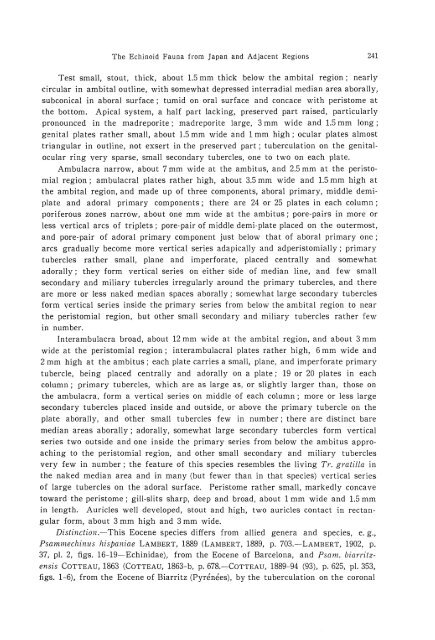the echinoid fauna from japan and adjacent regions part i
the echinoid fauna from japan and adjacent regions part i
the echinoid fauna from japan and adjacent regions part i
Create successful ePaper yourself
Turn your PDF publications into a flip-book with our unique Google optimized e-Paper software.
The Echinoid Fauna <strong>from</strong> Japan <strong>and</strong> Adjacent Regions<br />
Test small, stout, thick, about 1.5 mm thick below <strong>the</strong> ambital region; nearly<br />
circular in ambitaloutline, with somewhat depressed interradial median area aborally,<br />
subconical in aboral surface; tumid on oral surface <strong>and</strong> concace with peristome at<br />
<strong>the</strong> bottom. Apical system, a half <strong>part</strong> lacking, preserved <strong>part</strong> raised, <strong>part</strong>icularly<br />
pronounced in <strong>the</strong> madreporite; madreporite large, 3 mm wide <strong>and</strong> 1.5 mm long;<br />
genital plates ra<strong>the</strong>r small, about 1.5 mm wide <strong>and</strong> 1 mm high; ocular plates almost<br />
triangular in outline, not exsert in <strong>the</strong> preserved <strong>part</strong>; tuberculation on <strong>the</strong> genitalocular<br />
ring very sparse, small secondary tubercles, one to two on each plate.<br />
Ambulacra narrow, about 7 mm wide at <strong>the</strong> ambitus, <strong>and</strong> 2.5 mm at <strong>the</strong> peristomial<br />
region; ambulacral plates ra<strong>the</strong>r high, about 3.5 mm wide <strong>and</strong> 1.5 mm high at<br />
<strong>the</strong> ambital region, <strong>and</strong> made up of three components, aboral primary, middle demiplate<br />
<strong>and</strong> adoral primary components; <strong>the</strong>re are 24 or 25 plates in each column;<br />
poriferous zones narrow, about one mm wide at <strong>the</strong> ambitus; pore-pairs in more or<br />
less vertical arcs of triplets; pore-pair of middle demi-plate placed on <strong>the</strong> outermost,<br />
<strong>and</strong> pore-pair of adoral primary component just below that of aboral primary one;<br />
arcs gradually become more vertical series adapically <strong>and</strong> adperistomially; primary<br />
tubercles ra<strong>the</strong>r small, plane <strong>and</strong> imperforate, placed centrally <strong>and</strong> somewhat<br />
adorally; <strong>the</strong>y form vertical series on ei<strong>the</strong>r side of median line, <strong>and</strong> few small<br />
secondary <strong>and</strong> miliary tubercles irregularly around <strong>the</strong> primary tubercles, <strong>and</strong> <strong>the</strong>re<br />
are more or less naked median spaces aborally; somewhat large secondary tubercles<br />
form vertical series inside <strong>the</strong> primary series <strong>from</strong> below <strong>the</strong> ambital region to near<br />
<strong>the</strong> peristomial region, but o<strong>the</strong>r small secondary <strong>and</strong> miliary tubercles ra<strong>the</strong>r few<br />
in number.<br />
Interambulacra broad, about 12 mm wide at <strong>the</strong> ambital region, <strong>and</strong> about 3 mm<br />
wide at <strong>the</strong> peristomial region; interambulacral plates ra<strong>the</strong>r high, 6 mm wide <strong>and</strong><br />
2 mm high at <strong>the</strong> ambitus; each plate carries a small, plane, <strong>and</strong> imperforate primary<br />
tubercle, being placed centrally <strong>and</strong> adorally on a plate; 19 or 20 plates in each<br />
column; primary tubercles, which are as large as, or slightly larger than, those on<br />
<strong>the</strong> ambulacra, form a vertical series on middle of each column; more or less large<br />
secondary tubercles placed inside <strong>and</strong> outside, or above <strong>the</strong> primary tubercle on <strong>the</strong><br />
plate aborally, <strong>and</strong> o<strong>the</strong>r small tubercles few in number; <strong>the</strong>re are distinct bare<br />
median areas aborally; adorally, somewhat large secondary tubercles form vertical<br />
series two outside <strong>and</strong> one inside <strong>the</strong> primary series <strong>from</strong> below <strong>the</strong> ambitus approaching<br />
to <strong>the</strong> peristomial region, <strong>and</strong> o<strong>the</strong>r small secondary <strong>and</strong> miliary tubercles<br />
very few in number; <strong>the</strong> feature of this species resembles <strong>the</strong> living Tr. gratilla in<br />
<strong>the</strong> naked median area <strong>and</strong> in many (but fewer than in that species) vertical series<br />
of large tubercles on <strong>the</strong> adoral surface. Peristome ra<strong>the</strong>r small, markedly concave<br />
toward <strong>the</strong> peristome; gill-slits sharp, deep <strong>and</strong> broad, about 1 mm wide <strong>and</strong> 1.5 mm<br />
in length. Auricles well developed, stout <strong>and</strong> high, two auricles contact in rectangular<br />
form, about 3 mm high <strong>and</strong> 3 mm wide.<br />
DistinctioJl.-This Eocene species differs <strong>from</strong> allied genera <strong>and</strong> species, e. g.,<br />
Psammechinus hispaniae LAMBERT, 1889 (LAMBERT, 1889, p. 703.-LAMBERT, 1902, p.<br />
37, pI. 2, figs. 16-19-Echinidae), <strong>from</strong> <strong>the</strong> Eocene of Barcelona, <strong>and</strong> Psam. biarritzensis<br />
COTTEAU, 1863 (COTTEAU, 1863-b, p.678.-COTTEAU, 1889-94 (93), p.625, pI. 353,<br />
figs. 1-6), <strong>from</strong> <strong>the</strong> Eocene of Biarritz (Pyrenees), by <strong>the</strong> tuberculation on <strong>the</strong> coronal<br />
241












